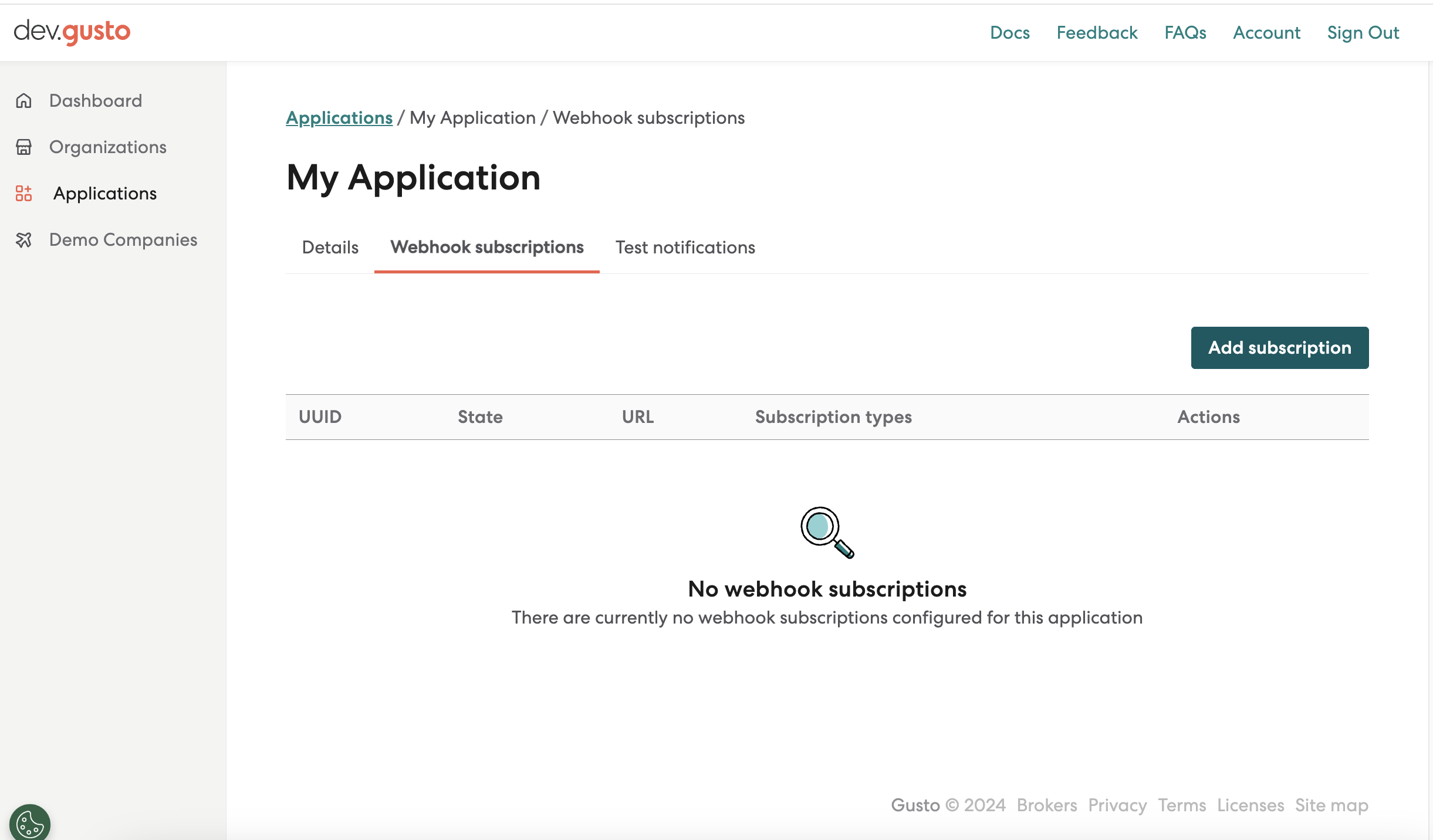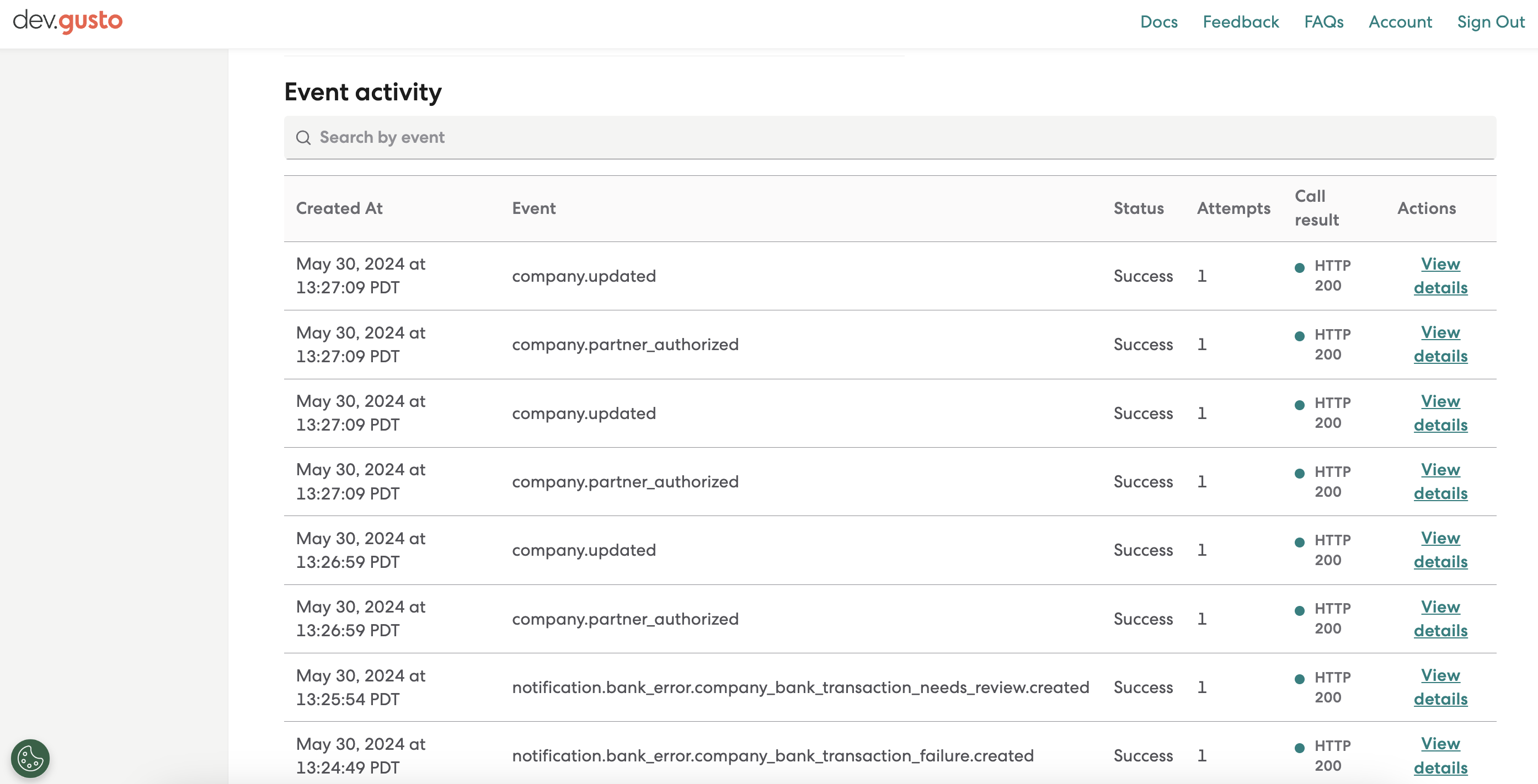Webhooks
Overview
A webhook is an HTTP request that delivers information about an event as it happens. We recommend that you integrate with Gusto’s webhooks infrastructure so that your application can perform subsequent business logic after it receives a webhook event.
A number of Gusto’s API endpoints are asynchronous in nature. For example, submitting an unprocessed payroll is an asynchronous process as the payroll is being calculated and processed. When a payroll is paid out, your application may leverage our payroll.paid event. Gusto will publish this webhook event when payroll credits have been generated and payments will be made.
See a list of all webhook event types that Gusto offers here.
Event payload
It’s possible that a single API request will generate multiple webhook events. For example, when a partner-managed company is created, we may push multiple events to your application.
Here is an example of a webhook event payload:
{
"uuid": "f7397a24-57ad-4fae-b011-d258e8232900",
"event_type": "company.provisioned",
"resource_type": "Company",
"resource_uuid": "5df911a0-e8e9-412d-8aaf-a46ad193dd96",
"entity_type": "Company",
"entity_uuid": "5df911a0-e8e9-412d-8aaf-a46ad193dd96",
"timestamp": 1671058841,
}The company.provisioned event indicates that an OAuth connection has been established between the company and the partner. Note that this event is always fired, regardless of whether your application has a subscription to the Company entity type.
For all webhook events, the resource_type will be Company.
The field entity_type refers to the underlying API resource with the state change.
Getting started
The easiest way to get started with our webhooks is by using our Developer Portal. If you would like to go through our API, instead, please see the section below.
- Sign into your Developer Portal account
- Click into the Application that your webhook will belong to
- Select the “Webhook subscriptions” tab. This tab will allow you to add, verify, edit, and view your webhook subscriptions.

Once your verified subscription starts receiving events, you will be able to view them in your subscription’s details page. You can use the Event activity table to view the last n events received, and can search by specific subscription types. Note that your subscription must be subscribed to the subscription type of interest in order to be notified of those events.
To access all events, regardless of your subscription status, you can ping our Events API.

Start receiving webhook events via API from Gusto by following the steps below:
1. Set up an HTTPS endpoint in your application that can accept webhook requests via a POST method.
Set up an HTTPS endpoint in your application that can accept webhook requests via a POST method.
Your endpoint should be able to handle POST requests with a JSON payload, and should quickly return a 2xx successful response within 10 seconds.
In absence of this acknowledgement, our system will assume delivery failure and continue to retry up to 16 times over the course of 3 days using an exponential backoff scheme.
2. Create a webhook subscription
When you create a webhook subscription, you should provide an initial set of subscription types that you’d like your application to receive. You may update this subscription at a later time. See all webhook event types here.
The url noted here should be your application’s webhook URL. Once created, the webhook subscription should be in pending status.
curl --request POST \
--url https://api.gusto-demo.com/v1/webhook_subscriptions \
--header 'accept: application/json' \
--header 'content-type: application/json' \
--header 'Authorization: Token API_TOKEN'\
--data '
{
"subscription_types": [
"Company",
"Employee"
],
"url": "https://leading-role-app.com/subscriber"
}
'const fetch = require('node-fetch');
const url = 'https://api.gusto-demo.com/v1/webhook_subscriptions';
const options = {
method: 'POST',
headers: {accept: 'application/json', 'content-type': 'application/json'},
body: JSON.stringify({
subscription_types: ['Company', 'Employee'],
url: 'https://leading-role-app.com/subscriber'
})
};
fetch(url, options)
.then(res => res.json())
.then(json => console.log(json))
.catch(err => console.error('error:' + err));3. Verify your new webhook subscription
Once the subscription has been created, we will send a POST request to your webhooks URL with a verification_token. This step helps Gusto validate that webhook events are reaching its intended destination, and helps you troubleshoot any issues with webhook delivery.
If your endpoint does not receive a verification_token, please ensure that your webhooks endpoint is set up correctly and actively listening.
Once you receive a verification_token, call the PUT webhook_subscriptions/{webhook_subscription_uuid}/verify endpoint to verify the endpoint and begin receiving webhook events.
We recommend that you save this verification_token for the next step. This token is used to help you verify that events were sent by Gusto.
curl --request PUT \
--url https://api.gusto-demo.com/v1/webhook_subscriptions/{webhook_subscription_uuid}/verify \
--header 'accept: application/json' \
--header 'content-type: application/json' \
--data '
{
"verification_token": "asefasedfe23e234easd"
}
'const fetch = require('node-fetch');
const url = 'https://api.gusto-demo.com/v1/webhook_subscriptions/{webhook_subscription_uuid}/verify';
const options = {
method: 'PUT',
headers: {accept: 'application/json', 'content-type': 'application/json'},
body: JSON.stringify({verification_token: 'asefasedfe23e234easd'})
};
fetch(url, options)
.then(res => res.json())
.then(json => console.log(json))
.catch(err => console.error('error:' + err));4. Secure your webhook endpoint
We highly recommend that your application verify the source of incoming webhook requests before processing events. While optional, this step is highly recommended to help prevent bad actors from engaging in unauthorized activities on your server.
Gusto computes a hash message authentication code (HMAC) of the event payload using the verification_token (provided in the verification step) as the secret, and SHA256 as the hash function. Webhook event payloads include a X-Gusto-Signature header, which is set to the computed HMAC.
You should compute the HMAC of your received event payload and check that it's equal to the HMAC sent to you in the X-Gusto-Signature header. If they match, then the event payload integrity is verified.
Updated 1 day ago